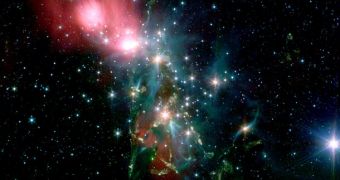Astronomers discovered some time ago that huge clouds of cosmic dust and gas tended to envelop regions that were extremely appropriate for the birth of new stars. In these areas, which have since been named stellar nurseries, the concentration of dust and gas is so great, that gravitational effects gather these elements into clouds. When a cloud becomes large enough, it collapses under its own weight, and then ignites to produce a new star. The size of the new celestial object depends entirely on the mass of the initial cloud, as well as on the chemical elements that went in it.
The processes that feed stellar formation are, however, fairly powerful and chaotic. The areas around the collapsed clouds are constantly battered with radiation of all sorts, and intense gravitational pulls tend to either rip the clouds apart, or force them more closely together. In some instances, dying stars in the clusters explode into novae, or supernovae. These explosions are so powerful that they can briefly outshine entire galaxies, and excessive amounts of radiation, such as X-rays and gamma-rays are produced. Highly energetic photons rip through the surrounding dust and gas, forcing numerous physical and chemical changes, and in the end feed the life and death cycle in the stellar nursery.
Such events have been recently discovered in the reflection nebula NGC 1333, which is located some 1,000 light-years away, in the constellation Perseus. Since the nursery itself is enveloped by huge and thick clouds of dust and gas, telescopes functioning in visible light wavelengths cannot see through them. For the recent observation, investigators used the Spitzer Space Telescope, one of NASA's four Great Observatories. In infrared wavelengths, such as the ones Spitzer uses, the intricate inner workings of the nurseries are revealed, because the stars at their cores are very hot.
The lower portion of the new image reveals that a large number of stars are spewing out jets that batter the gas clouds in their immediate vicinity. According to astrophysicists, this means that, over millions of years, the clouds will disperse, preventing the formation of new stars in this sub-group. Conversely, in the other sub-group of stars (upper part of the image), the reddish glow seems to indicate that the gas around the stars is warm, and undisturbed by violent radiation emissions. This means that it will most likely continue to produce new, blue stars, over the foreseeable future, Space Fellowship reports.

 14 DAY TRIAL //
14 DAY TRIAL //